
News Archive
| 2024 | 2023 | 2022 | 2021 | 2020 | 2019 | 2018 | 2017 | 2016 | 2015 | 2014 | 2013 | 2012 | 2011 | 2010 |
| December | November | October | September | August | July | June | May | April | March | February | January |
2009-06-30: Balboni honored with two-wheel drive Gallardo and Aston city-car ...
 One of Lamborghini's living legends, Valentino Balboni, has retired from the Italian manufacturer. He was employed by the Bolognese supercar company for most of its existence and served as test-driver for over forty years. From 1973 he has driven all Lamborghini prototypes and also sampled most of the road cars as well before they were delivered to customers. Among the marque's aficionados he has achieved a cult-status. To mark the occasion of his retirement, Lamborghini have labeled the latest addition to the Gallardo line-up, the LP550-2 Valentino Balboni. It will be the first Gallardo to feature just two driven wheels. Combined with a 550 bhp V10 engine, it will make for a proper driver's car and an appropriate salute to Balboni. The production run will be limited to just 250 examples. Hinting at Balboni's early years at the company, the first 'Valentino Balboni' has be painted and upholstered in the style of the classic models. Compare for example the Gallardo's paint scheme with this Miura S.
One of Lamborghini's living legends, Valentino Balboni, has retired from the Italian manufacturer. He was employed by the Bolognese supercar company for most of its existence and served as test-driver for over forty years. From 1973 he has driven all Lamborghini prototypes and also sampled most of the road cars as well before they were delivered to customers. Among the marque's aficionados he has achieved a cult-status. To mark the occasion of his retirement, Lamborghini have labeled the latest addition to the Gallardo line-up, the LP550-2 Valentino Balboni. It will be the first Gallardo to feature just two driven wheels. Combined with a 550 bhp V10 engine, it will make for a proper driver's car and an appropriate salute to Balboni. The production run will be limited to just 250 examples. Hinting at Balboni's early years at the company, the first 'Valentino Balboni' has be painted and upholstered in the style of the classic models. Compare for example the Gallardo's paint scheme with this Miura S.Since its independence Aston Martin has been one of the most active manufacturers, introducing new models, racing cars and concepts almost every two months. This week the British manufacturer has launched their wildest concept yet. Wild not because it uses a 1000+ bhp engine or seats just one but because it's a supermini. Based on the universally acclaimed Toyota iQ, it is called the Cygnet Concept. The engineers have given the three-seater the Aston Martin treatment inside and out. One of the possibilities for a car like this may be to sell them in combination with the more traditional Aston Martin models as an every day city car. |
2009-06-28: The two superstars of the 1952 season: Ferrari 500 F2 and Mercedes-Benz 300 SL Competition Coupe ...
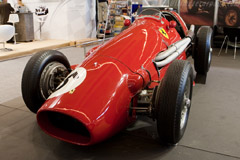 Today Ferrari is the most successful of all Formula 1 teams. Their championship winning run started in 1952, with a Formula 2 car as for that year the Grand Prix World Championship was run under Formula 2 regulations. Timed perfectly, Ferrari replaced their first Formula 2 car with the brand new 500 F2. Debuting a straight four, it was the very first Ferrari not powered by a V12 engine. Enzo Ferrari's choice to adopt the four cylinder was inspired by the very potent British F2 cars that used a similar design. Alberto Ascari underlined that Ferrari's interpretation of the design was superior, winning all but one of the 1952 European rounds of the championship. The other was won by his team-mate Piero Taruffi. The success continued the following season although Ferrari did lose one of the European rounds to Juan Manuel Fangio. Ascari was the first Ferrari driver to be crowned World Champion, a feat he repeated a year later. The four-cylinder Ferraris were raced for many more seasons in various championships, often in highly modified form. Our article is illustrated by 12 pictures of two surviving cars. One of them was originally raced by Ascari and is considered one of the most successful Grand Prix chassis ever built.
Today Ferrari is the most successful of all Formula 1 teams. Their championship winning run started in 1952, with a Formula 2 car as for that year the Grand Prix World Championship was run under Formula 2 regulations. Timed perfectly, Ferrari replaced their first Formula 2 car with the brand new 500 F2. Debuting a straight four, it was the very first Ferrari not powered by a V12 engine. Enzo Ferrari's choice to adopt the four cylinder was inspired by the very potent British F2 cars that used a similar design. Alberto Ascari underlined that Ferrari's interpretation of the design was superior, winning all but one of the 1952 European rounds of the championship. The other was won by his team-mate Piero Taruffi. The success continued the following season although Ferrari did lose one of the European rounds to Juan Manuel Fangio. Ascari was the first Ferrari driver to be crowned World Champion, a feat he repeated a year later. The four-cylinder Ferraris were raced for many more seasons in various championships, often in highly modified form. Our article is illustrated by 12 pictures of two surviving cars. One of them was originally raced by Ascari and is considered one of the most successful Grand Prix chassis ever built.While Ferrari dominated single seater racing, Mercedes-Benz picked up the big sports car trophy with the 300 SL Competition Coupe. It was the first of the German company's spaceframe designs that was developed into the W196 Grand Prix car and the legendary 'Gullwing' 300 SL. The Le Mans winning machine combined the cutting edge chassis with a road-car derived straight six engine. Like the later road car, it used 'gullwing' style doors to clear the relatively high sills. In preparation for the Le Mans race, Mercedes-Benz tested a roof mounted air-brake on one of the cars but decided not to race it. Both the Le Mans winning machine and the unsuccessful test car are pictured in our 18-shot gallery. |
|
2009-06-26: Group 44's XJR-5; the car that brought Jaguar back to Le Mans ...
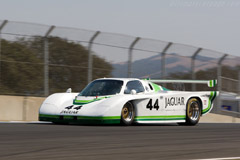 It has been exactly 25 years this month since Jaguar officially made its return to the 24 Hours of Le Mans after an absence of over two decades. With five victories in the 1950s, Jaguar ranked as one of the race's successful manufacturers but it was a private effort that took the 'Leaping Cat' back to the legendary endurance event. For many years American Bob Tullius had campaigned a wide variety of British Leyland machines, including several Jaguars, in North American events under the Group 44 banner.
It has been exactly 25 years this month since Jaguar officially made its return to the 24 Hours of Le Mans after an absence of over two decades. With five victories in the 1950s, Jaguar ranked as one of the race's successful manufacturers but it was a private effort that took the 'Leaping Cat' back to the legendary endurance event. For many years American Bob Tullius had campaigned a wide variety of British Leyland machines, including several Jaguars, in North American events under the Group 44 banner.Shortly after IMSA introduced the new Grand Touring Prototype (GTP) regulations for the 1982 season, Tullius commenced with his most ambitious project yet; the development of a Jaguar engined prototype. With the backing of Jaguar North America, he had Lee Dykstra draw up an aluminum monocoque that used the company's V12 engine as a fully stressed member. The end-result was the Jaguar XJR-5 that was first raced in the summer of 1982. It immediately made its marque by finishing third overall and first in class at its debut. In the following years Group 44 raced in the highly popular IMSA GTP series with a two-car team. Numerous victories were scored against very strong opposition. In attempt to attract more (American) entrants, the Le Mans organizers decided to also include a GTP class for the 24 Hour race. This enabled Tullius to bring his team over to Europe and compete in the event. Although the XJR-5 struggled at Le Mans, Group 44 scored a popular GTP class win in 1985. Tullius' efforts had awakened the racing spirit at Jaguar, which eventually led to two victories for the TWR prepared XJR-9 and XJR-12. Today we commemorate the machine that was solely responsible for another golden era of sports car racing for the Coventry based manufacturer. Group 44 raced a total of 10 chassis of which at least two were destroyed in accidents. Our 18-shot gallery features five of the surviving machines and illustrates a detailed article of the XJR-5's history. One of the ex-Le Mans cars is shown back at the French track while the very first chassis built is pictured in the hands of Bob Tullius himself. |
2009-06-24: Goodwood preview: Senna's McLaren, Zonda R, Citro�n GT and Grand Prix Sunbeam ...
 As you may have noticed we have been quietly building up to the upcoming Goodwood Festival of Speed with our recent features of the Bentley Speed 8 and the Williams FW07B. Today we take a closer look at four cars expected to make an appearance at Goodwood between July 3rd and 5th.
As you may have noticed we have been quietly building up to the upcoming Goodwood Festival of Speed with our recent features of the Bentley Speed 8 and the Williams FW07B. Today we take a closer look at four cars expected to make an appearance at Goodwood between July 3rd and 5th.One of the most anticipated cars to race up the hill is the McLaren MP4/4 Honda that was used by Ayrton Senna to win his first World Championship. Seeing one of the very best racing cars ever built in action is already a treat but at Goodwood it gets even better: Lewis Hamilton will get a chance to drive the car of his childhood hero and Ayrton's nephew Bruno Senna is also scheduled to drive. Taking over from the British Motor Show, the Festival of Speed now also serves as the venue for new car introduction. Well over two-dozen cars will celebrate their (British) debut at Goodwood. We are especially looking forward to seeing the Citro�n GT Concept in action. As it was originally conceived as a dream car for the popular Gran Turismo computer game, we were very surprised to learn it could actually move. Also built to move, and very quickly, is the Pagani Zonda R. Two years in the making, it was finally revealed earlier this year at the Geneva Motor Show. Goodwood will be the first opportunity for us to capture the car on the move. At the traditional auction on Friday, Bonhams offers an eclectic selection of road and racing cars. The sale is highlighted by a race-prepared Ford GT40, which is generally considered to be one of the fastest in existence. Our eye was caught by this fabulous Sunbeam 2-Litre Grand Prix. Four of these were built for the 1922 French Grand Prix and our article includes pictures of both the chassis that will be auctioned and a sister car that is seen in action at Goodwood last year. Much more Goodwood news can be found in our dedicated Goodwood FoS thread. Tickets are still available and can be ordered on the official Goodwood website. Our full report will follow a few days after the event. |
|
2009-06-22: 2003 Le Mans winning Bentley Speed 8 and the all new 'Grand' Bentley ...
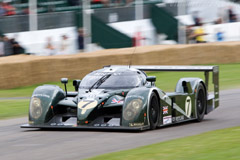 Last week we saw Audi being beaten at Le Mans for the first time since 2003. That year the victory was for the Bentley Speed 8. With Joest running the car, two Audi drivers behind the wheel and an Audi derived engine, the German manufacturer does deserve some credit for that win as well. The car itself was however developed completely independent from Audi and was the culmination of a three year program that already resulted in two class wins in 2001 and 2002 for the experimental EXP Speed 8. The Speed 8 continued where the Speed 6 had left seven decades earlier when it claimed Bentley's fourth and fifth Le Mans win in the classic era. Penned by Peter Elleray, the Speed 8 had highly advanced aerodynamics that influenced many of the prototype racers that have been built since. Unfortunately the striking Bentley did not get the opportunity to face any of them as the company withdrew from racing immediately after achieving their objective. All this and much more can be read in our Speed 8 article, which is illustrated by a 12-shot gallery, depicting the winning car at last year's Goodwood Festival of Speed.
Last week we saw Audi being beaten at Le Mans for the first time since 2003. That year the victory was for the Bentley Speed 8. With Joest running the car, two Audi drivers behind the wheel and an Audi derived engine, the German manufacturer does deserve some credit for that win as well. The car itself was however developed completely independent from Audi and was the culmination of a three year program that already resulted in two class wins in 2001 and 2002 for the experimental EXP Speed 8. The Speed 8 continued where the Speed 6 had left seven decades earlier when it claimed Bentley's fourth and fifth Le Mans win in the classic era. Penned by Peter Elleray, the Speed 8 had highly advanced aerodynamics that influenced many of the prototype racers that have been built since. Unfortunately the striking Bentley did not get the opportunity to face any of them as the company withdrew from racing immediately after achieving their objective. All this and much more can be read in our Speed 8 article, which is illustrated by a 12-shot gallery, depicting the winning car at last year's Goodwood Festival of Speed.Our article on the upcoming 'Grand Bentley' is not nearly as detailed. That is the result of Bentley only releasing one teaser picture and a very short description of what will become the Arnage replacement. |
2009-06-19: Williams' first World Champion and a glimpse of the Audi A5 Sportback ...
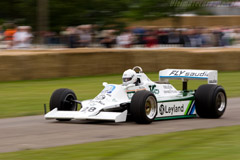 Very early this morning the unthinkable happened; eight of the ten Formula 1 teams announced they would split from the FIA sanctioned Grand Prix World Championship from 2010 onwards. United in the Formula One Teams Association, the likes of Ferrari, McLaren, Renault and BMW could not find common ground with the sport's governing body. The main subject of dispute is the budget cap, which would come into effect next year. For some teams this meant they would have to continue at only 10% of their original budget. This is probably not nearly the end of the politicking and hopefully a sensible solution can still be found.
Very early this morning the unthinkable happened; eight of the ten Formula 1 teams announced they would split from the FIA sanctioned Grand Prix World Championship from 2010 onwards. United in the Formula One Teams Association, the likes of Ferrari, McLaren, Renault and BMW could not find common ground with the sport's governing body. The main subject of dispute is the budget cap, which would come into effect next year. For some teams this meant they would have to continue at only 10% of their original budget. This is probably not nearly the end of the politicking and hopefully a sensible solution can still be found.One of the two existing teams that have decided to stick with Formula 1 is Williams. A true stalwart of Formula 1, the British team was particularly successful in the 1980s and 90s, winning numerous races and championships. Their first really successful car was the Cosworth engined FW07B built for the 1980 season. Making the most of the ground-effects pioneered by Colin Chapman a few years earlier, the white and green racer was driven to six wins in fourteen races. Five of these victories were scored by Australian Alan Jones, which was sufficient to secure the driver's and manufacturer's championship. The feature example was used by Jones for most of the year. He drove the car to two Grand Prix wins and two further victories in non-championship events. It is pictured at the 2008 Goodwood Festival of Speed where it nearly recorded the fastest time. At this year's 'FoS' Jones will be reunited with his old FW07B. Completely unrelated is Audi's new A5 Sportback of which the first teaser picture and sketch have been released. A mix of the A4 and A5, it continues the four-door coupe trend. Diesel and petrol engines will be available, mated to an 8-speed gearbox. The complete car is expected to be launched at the Frankfurt Motor Show in September. |
|
2009-06-17: 2009 24 Hours of Le Mans report and slideshow ...
 At 3 pm this past Saturday 55 roaring racing cars took off for the 77th edition of the 24 Hours of Le Mans. The legendary twice around the clock race has long since been dominated by Audi but in the last two editions Peugeot came very close to break the stronghold. The French manufacturer returned for a third stab at glory with the blisteringly fast 908 HDI Fap, which faced Audi's brand new R15 TDI. Behind the six protagonists there was a high quality field with talented drivers and fabulous racing cars. In one of the classes the age-old rivalry between Ferrari and Porsche was disputed once again, while in the other a future classic, the works Corvette C6.R, celebrated its final race in great style. Obvious crowd favorites were the Lola-Aston Martins that combined the classic Gulf livery with a glorious engine note. Local boys Pescarolo Sport could also count on plenty of support, this year fielding a 2008-spec Peugeot and one of their own Judd-engined machines.
At 3 pm this past Saturday 55 roaring racing cars took off for the 77th edition of the 24 Hours of Le Mans. The legendary twice around the clock race has long since been dominated by Audi but in the last two editions Peugeot came very close to break the stronghold. The French manufacturer returned for a third stab at glory with the blisteringly fast 908 HDI Fap, which faced Audi's brand new R15 TDI. Behind the six protagonists there was a high quality field with talented drivers and fabulous racing cars. In one of the classes the age-old rivalry between Ferrari and Porsche was disputed once again, while in the other a future classic, the works Corvette C6.R, celebrated its final race in great style. Obvious crowd favorites were the Lola-Aston Martins that combined the classic Gulf livery with a glorious engine note. Local boys Pescarolo Sport could also count on plenty of support, this year fielding a 2008-spec Peugeot and one of their own Judd-engined machines.Although there were numerous incidents in the race, it was not a classic like last year's. It will nevertheless find a spot in the very rich history of the 24 Hours of Le Mans. It was fulfilling to see each of the classes being won by a deserving team and on merit. We were in Le Mans for the full duration of the event from the scrutineering at the Place des Jacobins on Monday all the way through to the podium ceremonies late Sunday afternoon. This has resulted in a 2650-word report and an exclusive 260-shot gallery with pictures from scrutineering, practice, qualifying, the Le Mans Legends and of course the race. |
2009-06-12: 24 Hours of Le Mans practice and qualifying gallery ...
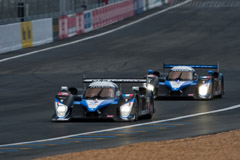 At exactly 6 pm on Wednesday afternoon, the 55 entries of the 78th annual 24 Hours of Le Mans took to the track for the first time for a six hour practice session. With no test day this year, the teams were pressed for time to get the cars set up and the new drivers qualified for the race. To complicate things even more, the track was wet at the start of the session and it started to rain not much later. Despite the difficult conditions, remarkably few cars got badly damaged and certainly not beyond repair. An Audi was quickest but the times were hardly representative.
At exactly 6 pm on Wednesday afternoon, the 55 entries of the 78th annual 24 Hours of Le Mans took to the track for the first time for a six hour practice session. With no test day this year, the teams were pressed for time to get the cars set up and the new drivers qualified for the race. To complicate things even more, the track was wet at the start of the session and it started to rain not much later. Despite the difficult conditions, remarkably few cars got badly damaged and certainly not beyond repair. An Audi was quickest but the times were hardly representative.Meanwhile a dark cloud of protests hung over the evening as Peugeot had officially protested the legality of the Audi's nose. Not surprisingly the initial protest has been thrown out by the ACO but Peugeot is persisting and plans to take it all the way to the FIA World Council in Paris. Hopefully we will not get the race decided behind the green table. Thursday evening was reserved for two two-hour qualifying sessions. This time round the track was actually dry so the teams had to find a balance between finding a good race setup and get a good time in. Audi focused mostly on setup and investigated just how far they could push the Michelin tires. The #1 car managed to do four stints on one set. In the dying seconds of the first session fresh rubber was fitted to the car, enabling McNish to put in a stellar lap. It took Stephane Sarrazin two sets of tires and six laps to beat it some two hours later. In doing so he scored his and Peugeot's third Le Mans pole in a row. Behind them the two Porsche RS Spyders clinched the LMP2 class by a landslide. GT1 was a similar story with the Works Corvettes clocking much faster times than the rest. The second GT class was a little closer but the two fastest Porsches were still nearly a second faster than the Ferraris. The race for the overall as well as the GT2 class will most likely go down to the wire. Warming up for the race we were trackside on both days and have added a further 60 shots to our growing 24 Hours of Le Mans gallery. |
|
2009-06-10: 2009 24 Hours of Le Mans preview ...
 The first practice session of this year's 24 Hours of Le Mans is about to get under way. Unlike most other editions, there has been no test day so this will be the very first time many of the cars will hit the legendary track. Although some costs may have been cut, it has not made life any easier for the teams or us reporters looking ahead to the big race. With some well educated guesswork, we have nevertheless compiled a class by class preview.
The first practice session of this year's 24 Hours of Le Mans is about to get under way. Unlike most other editions, there has been no test day so this will be the very first time many of the cars will hit the legendary track. Although some costs may have been cut, it has not made life any easier for the teams or us reporters looking ahead to the big race. With some well educated guesswork, we have nevertheless compiled a class by class preview.As has been the case for some years now, the grid is divided in two prototype and two grand touring classes. The fastest machines and the most likely candidates to score the overall the outright wins are the cars in the LMP1 class. More specifically the works Audis and Peugeots that will go head to head for the third year in a row. The German team will race the brand new R15 TDI against the well sorted 908 HDI Fap. It looks certain to be another closely disputed race with perhaps a surprising winners. Hot on their heels will be the Aston Martin team, who celebrate the fiftieth anniversary of their Le Mans win back in 1959. In the 'smaller' LMP2 class things are a little more straightforward with one of the Porsches most likely to grab the win. The two examples entered finished first and second last year. By far the smallest class is GT1 with only six cars. The only works effort is Corvette Racing, who most likely will be giving their superb Corvette C6.R a farewell victory. Quite possibly the most difficult class to call is GT2 with its age-old Porsche vs Ferrari battle. On both sides there are several good teams that are quite capable of taking the win. A more detailed rundown of the classes as well as a link to every single type of car entered in the race can be found in our exclusive preview. It also includes a twenty-shot gallery with the first images from the track and scruteneering. For a more technical look at the Le Mans race, we strongly recommend the technical preview from our friends at Racecar Engineering. We will be on the track the coming days and will provide a full qualifying report on Friday and a well illustrated look at the race early next week. |
2009-06-07: Le Mans Preview: Aston Martin returns to site of their most legendary victory ...
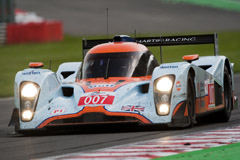 On June 21st 1959, Aston Martins finished 1st and 2nd in the 24 Hours of Le Mans. Now fifty years later the British manufacturer returns to the scene of their biggest victory with a contender for the overall win. This is the first time Aston Martin competes in the premier class at Le Mans since 1989. Today we kick off our 24 Hours of Le Mans coverage with a look at two of Aston Martin's current Le Mans cars, the 1989 entry and of course the 1959 winner.
On June 21st 1959, Aston Martins finished 1st and 2nd in the 24 Hours of Le Mans. Now fifty years later the British manufacturer returns to the scene of their biggest victory with a contender for the overall win. This is the first time Aston Martin competes in the premier class at Le Mans since 1989. Today we kick off our 24 Hours of Le Mans coverage with a look at two of Aston Martin's current Le Mans cars, the 1989 entry and of course the 1959 winner.The Aston Martin Racing team will field two Lola-Aston Martin B09/60s next weekend to try and win the race for the first time in fifty years. In addition to the Works entry a similar car will be entered by a satellite team and a fourth 2008-spec Aston Martin engined Lola. The Gulf liveried machines already scored a victory earlier this season and are the most likely challengers for the diesel engined Audis and Peugeots. Also making its Le Mans debut is the Aston Martin V8 Vantage GT2. A single example is entered by Drayson Racing and will be campaigned by Lord Drayson, Johnny Cocker and Marino Franchitti. The rumbling coupe is an outsider for a podium finish. Aston Martin's most recent attempt to clinch an outright Le Mans win was in 1989 with the AMR1. Powered by a booming V8, the car was still well under development when it campaigned at Le Mans. The program unfortunately was canceled prematurely after owner Ford also added Jaguar to their stable. A decade of racing came to fabulous close with the one-two 1959 Le Mans victory. It was achieved with the DBR1, which had been gradually developed to a successful endurance racer since its debut in 1956. In addition to winning Le Mans, Aston Martin was also crowned World Champion. Our DBR1 article is illustrated by 24-shots of four of the five cars built. Included is chassis DBR1/2, which not only won Le Mans but also five other major races, making it the most successful Aston Martin racing car ever built. |
|
2009-06-04: Four fantastic Formula 1 cars including the new Brawn, Villeneuve's Ferrari and Senna's Lotus ...
 The start of the 2009 Formula 1 season has not gone by unnoticed. In this update we take a closer look at this year's key player and three fantastic F1 cars from the past.
The start of the 2009 Formula 1 season has not gone by unnoticed. In this update we take a closer look at this year's key player and three fantastic F1 cars from the past.The absolute star of the first six races is the Brawn GP BGP 001, which was driven to victory five times by Jenson Button. It has been a real fairytale for the team that did not exist a month before the start of the season. Built on the remains of the Honda team, Brawn GP has made the most of the head-start they had while developing the new 2009 contender. Although not the prettiest of cars, the Mercedes-Benz engined BGP 001 has already deserved a place in F1's rich history alongside the following three machines. The oldest is the Porsche 804 F1 built for the 1962 season. American Dan Gurney used it to score the German manufacturer's only Grand Prix win. The featured example was used mostly by Gurney's team-mate Jo Bonnier and has survived in a breathtakingly original condition. Our 12-shot gallery reveals most of the car's many unusual features. Well over a decade later Gilles Villeneuve used the Ferrari 312 T3 to clinch his maiden victory at his home race during the inaugural Grand Prix on the Ile de Montreal. In the hands of Carlos Reutemann, the T3 had scored three more victories but ultimately it was outpaced by the ground-effects Lotus 79. Included in our article are three of the five 312 T3s built. It was at Lotus, in the mid-1980s, that Ayrton Senna became a regular Grand Prix winner. In 1986 he campaigned the 98T, which he drove to two victories. Even more impressive were his eight pole positions. The 98T was the last Lotus to wear the legendary JPS colors and the last Lotus powered by the twin-turbo Renault engine. |
2009-06-01: Legendary Corvette Grand Sport and Camaro SS to soften the GM Chapter 11 pain ...
 Today looks set to become a turning point in General Motors' history. Two years ago GM was still the worlds largest car maker, as of today, the company has filed for Chapter 11 bankruptcy protection. With the help of the American government, who have taken a 60% stake, the Detroit manufacturer hopes to start back from scratch. We will not bore you with the financial details but instead we have taken a closer look at two of the company's finest products to show just why the American manufacturer should survive.
Today looks set to become a turning point in General Motors' history. Two years ago GM was still the worlds largest car maker, as of today, the company has filed for Chapter 11 bankruptcy protection. With the help of the American government, who have taken a 60% stake, the Detroit manufacturer hopes to start back from scratch. We will not bore you with the financial details but instead we have taken a closer look at two of the company's finest products to show just why the American manufacturer should survive.First up is our all time favourite GM racing car, the Chevrolet Corvette Grand Sport. Built against the wishes of the top brass, this lightweight competition car was developed in secrecy by the Corvette's spiritual father Zora-Arkus Duntov. Although they looked somewhat similar to the road-going Corvettes, under the fiberglass body they were bespoke racing cars. On the track the Grand Sport proved more than a match for the Cobra endorsed by GM's big rival Ford. The executives nevertheless called for the cars to be destroyed once they found what had happened right under their noses. Fortunately, the cars were quietly sold to privateers, who continued to race the very special Corvettes. Our article includes two of the three surviving coupes. Both have been restored to their 1964 Sebring 12 Hours specification livery and are pictured at recent outings at events like the Monterey Historics and The Quail, a Motorsports Gathering. Slightly more civilized is this first generation Chevrolet Camaro SS. Built between 1967 and 1969 these earliest Camaros are the most sought after. It is hardly surprisisng that for the new Camaro, the original bodystyle served as an inspiration. The pictured example is seen at the 2008 Concours on the Avenue in Carmel, shortly after a complete restoration. Hopefully the slimmed down General Motors will continue to build road and racing cars like these two in the future. |
| All Cars - Contact us - Privacy Statement - Top | © 1998 - 2024 Ultimatecarpage.com |

